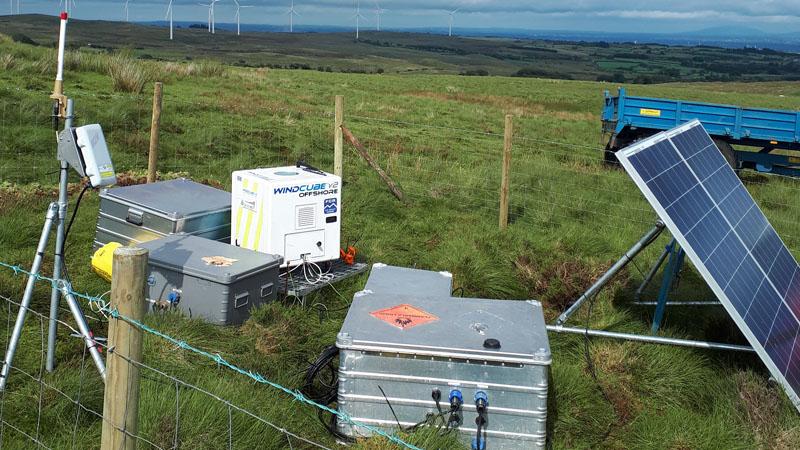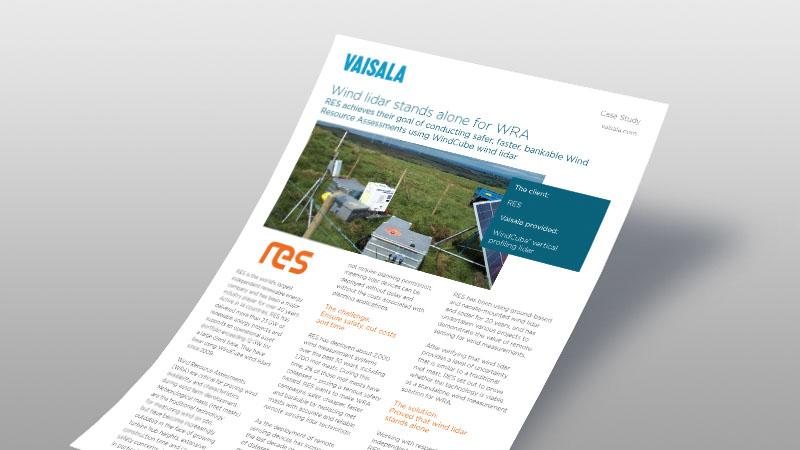Wind lidar stands alone for WRA
RES achieves their goal of conducting safer, faster, bankable Wind Resource Assessments using WindCube wind lidar.
The client: RES
Vaisala provided: WindCube® vertical profiling lidar
RES is the world's largest independent renewable energy company and has been a major industry player for over 40 years. Active in 14 countries, RES has delivered more than 23 GW of renewable energy projects and supports an operational asset portfolio exceeding 12 GW for a large client base. They have been using WindCube wind lidars since 2009.
Wind Resource Assessments (WRA) are critical for proving wind availability and characteristics during wind farm development. Meteorological masts (met masts) are the traditional technology for measuring wind on site, but have become increasingly outdated in the face of growing turbine hub heights, extensive construction time and costs, and safety concerns, among others.
In particular, lidar deployments do not require planning permission, meaning lidar devices can be deployed without delay and without the costs associated with planning applications.
The challenge: Ensure safety, cut costs and time
RES has deployed about 2,000 wind measurement systems over the past 30 years, including 1,700 met masts. During this time, 2% of those met masts have collapsed — posing a serious safety hazard. RES wants to make WRA campaigns safer, cheaper, faster and bankable by replacing met masts with accurate and reliable remote sensing lidar technology.
As the deployment of remote sensing devices has increased over the last decade or so, the number of datasets for collocated met mast and remote sensing pairs has also grown, along with their acceptance for quantitative use in WRA.
RES has been using ground-based and nacelle-mounted wind lidar and sodar for 20 years, and has undertaken various projects to demonstrate the value of remote sensing for wind measurements. After verifying that wind lidar provides a level of uncertainty that is similar to a traditional met mast, RES set out to prove whether the technology is viable as a standalone wind measurement solution for WRA.
The solution: Proved that wind lidar stands alone
Working with respected, independent industry engineers, RES conducted a 12-month standalone lidar measurement study at the Corlacky Hill wind farm site in Northern Ireland. This 11 turbine, 47 MW wind farm, owned by ERG, is set in gently sloping, relatively benign terrain with minimal forestry.
RES selected a Vaisala WindCube vertical profiling wind lidar for the project. Trusted as the gold standard worldwide, WindCube excels in every aspect of wind measurement projects — onshore and offshore, from simple to complex terrain.
Prior to deployment, DNV verified the lidar offsite against a tall met mast at their Janneby test site. The lidar installation was then completed in one day with no safety incidents. DNV used the WindCube lidar measurements as the sole wind measurements for their independent energy production assessment for the wind farm. Wind turbine manufacturers also received the data to conduct turbine suitability assessments.
The results: Verified accuracy, safety and bankability
WindCube exceeded RES’ expectations. The wind lidar’s overall measurement uncertainty applied to the lidar at hub height was 2.4%, based on the IEC recommendations for assessing uncertainty and weighted by the site-specific wind frequency distribution observed at Corlacky Hill.
The project obtained a p90/p50 value of about 90% — which achieved market standard uncertainty levels and was greater than the expected market threshold. The lidar data was accepted and considered bankable by all parties. DNV produced their independent energy production assessment, and RES sold the wind farm to ERG.
RES sees four distinct advantages that lidar has over met masts:
- Safety: There is a small and unnecessary safety risk of using a met mast when wind lidar is acceptable.
- Bias: When using a met mast shorter than hub height, there can be bias in the hub height wind speed from the vertical extrapolation of the mast measurements to hub height (if the shear observed by the mast is not representative for the extrapolation to hub height).
- Uncertainty: When using a met mast shorter than hub height, there can be an increased uncertainty on the hub height wind speed from the vertical extrapolation of the mast measurements to hub height, compared with the lidar hub height measurements.
- Cost: Traditional wind measurement campaigns using met masts for primary measurements are significantly more expensive than lidar.
"Our current standalone remote sensing measurement strategy is borne out of the work undertaken at Corlacky Hill and another wind farm in northern Scotland. Not only does this strategy result in safer, bankable measurement campaigns, a 12-month standalone lidar measurement campaign is also faster (no planning or permission delays) and cheaper (37% savings) than a traditional met mast measurement campaign." Iain Campbell, Senior Technical Analyst and Wind Resource Manager, RES

